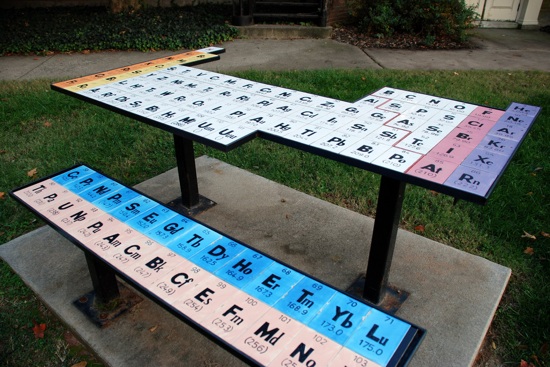Check deze vette tafel! Die wil ik ook (in de universiteitstuin)! Dan kunnen we weer woorden maken met elementen.

Of zoals Anonymous al opmerkte:
H Am B U Rg Er, Fr I Es and Co O K I Es.
Gezien op Make Magazine
Check deze vette tafel! Die wil ik ook (in de universiteitstuin)! Dan kunnen we weer woorden maken met elementen.

Of zoals Anonymous al opmerkte:
H Am B U Rg Er, Fr I Es and Co O K I Es.
Gezien op Make Magazine
Iedereen kent The Element Song van Tom Lehrer uit 1959. Ofwel, elke rechtgeaarde chemicus. Het lied bevat alle elementen tot en met atoomnummer 102, dus de elementen tot en met 111 ontbreken (ik reken copernicium nog niet mee).
Een paar jaar daarna is door Robbert Paul een Nederlandse versie gemaakt (in de jaren ’60). Merk op dat in de Nederlandse versie, sommige elementen meerdere malen voorkomen en anderen juist ontbreken. Kan iemand ontdekken welke?
Video gezien op Kennislink
Gevonden in een verre zijstraat van het Internet. Een verhaal van een professor thermodynamica die een cynische vraag stelde in een tentamen.
Fun With Entropy: Thermodynamics of Hell
A thermodynamics professor had written a take home exam for his graduate students. It had one question: Is hell exothermic (giving off heat) or endothermic (taking in or absorbing heat)? Support your answer with a proof.
Most of the students wrote proofs of their beliefs using Boyle’s Law or some variant. One student, however, wrote the following:First, we postulate that if souls exist, then they must have some mass. If they do, then a mole of souls can also have a mass. So, at what rate are souls moving into hell and at what rate are souls leaving? I think that we can safely assume that once a soul gets to hell, it will not leave. Therefore, no souls are leaving. As for souls entering hell, let’s look at the different religions that exist in the world today. Some of these religions state that if you are not a member of their religion, you will go to hell. Since there are more than one of these religions and people do not belong to more than one religion, we can project that all people and all souls go to hell. With birth and death rates as they are, we can expect the number of souls in hell to increase exponentially. Now, we look at the rate of change in volume in hell. Boyle’s Law states that in order for the temperature and pressure in hell to stay the same, the ratio of the mass of souls and volume needs to stay constant.
A1: So, if hell is expanding at a slower rate than the rate at which souls enter hell, then the temperature and pressure in hell will increase until all hell breaks loose.
A2: Of course, if hell is expanding at a rate faster than the increase of souls in hell, then the temperature and pressure will drop until hell freezes over.So which is it? If we accept the postulate given to me by Therese Banyan during Freshman year, that “it will be a cold night in hell before I sleep with you” and take into account the fact that I still have not succeeded in having sexual relations with her, then A2 cannot be true, and hell is exothermic.
The student got the only A.
Science Cafés zijn een wereldwijd initiatief om mensen in contact te brengen met wetenschap. Het is een ontmoetingsplek voor iedereen die geïnteresseerd is in wetenschap. Er worden (meestal maandelijks) lezingen gehouden door wetenschappers waarna er gelegenheid is voor vragen en discussie.
In andere steden en landen bestonden al enige tijd Science Cafés, maar sinds kort hebben we er ook dus ook eentje in Zeist. Het Science Café Zeist wordt gehouden in het Natuurcafé op station Driebergen-Zeist en het is elke tweede donderdag van de maand geopend. De eerstvolgende bijeenkomst is morgen en gaat over nanotechnologie. De Scheikundejongens zijn erg benieuwd en gaan zeker een kijkje nemen. Als je ons de hand weet te schudden én ons kunt uitleggen wat soxhletten is, krijg je een spetterende, niet gedestilleerde prijs.
Heb jij je ook wel eens afgevraagd hoe klein dingen zijn? Gewoon, in het algemeen. Ik kwam deze flash tegen op de site van de universiteit van Utah (dat ligt in de Verenigde Staten). Hij toont hoe groot een lettergrootte 12 punten is (millimeterschaal). Daarna kun je inzoomen tot een koolstofatoom (picometerschaal). Ik vind wel dat er indrukwekkend veel tussen ligt.
De rest van de site staat vol met informatie over biochemie en celbiologie. Ze hebben ook een mooie verzameling informatieve fimpjes over cellen. De dynamica en communicatie van cellen word goed beschreven en er wordt goed gebruik gemaakt van wat Internet en flash allemaal kan.
Ook hebben ze een serie virtual labs: als je meer wil weten over DNA extractie, PCR, gel electrophoresis of DNA microarrays kun je ook bij hen terecht. Ergens anders op de site wordt ook uitgelegd hoe je van DNA naar eiwit komt. Supervet.
Alle scheikunde- en biologieleraren verzamelen! Gebruik deze in je les!